-
C++ string类介绍以及模拟实现
string介绍
何为string?
string是一个类,准确的说string是一个类模板的实例化

类模板是basic_string,所以string是用char作为模板参数实例化的一个类对象
除了实例string,还有其他三个实例wstring:针对宽字符的类(国标)
u16string:针对字符大小为2字节的类(utf-16)
u32string:针对字符大小为4字节的类(utf-32)总之根据编码的标准不同,实例化的类也随之不同,string类的字符大小是1字节,是针对ASCII码的一个类。
string的构造函数

上面是string的所用构造函数,下面列出几个常用的void stringTest1() { string str1;// 构造一个空的string对象 string str2("hello world"); // 用const char *s构造一个string对象 cout << str2 << endl; string str3(str2); // 用str2拷贝构造str3 cout << str3 << endl; string str4 = str3; // 本质上不是赋值,而是拷贝构造 cout << str4 << endl; // 不太常用 string str5("hello world", 3); // 用字符串的第3个到结束的字符构造 cout << str5 << endl; string str6(10, 'x'); // 用十个x字符构造 cout << str6 << endl; string str7(str2, 3); // 用str2的第3个到结束的字符构造 cout << str7 << endl; string str8(str2, 3, 7); // 用str2的第3个到第7个的字符构造 cout << str8 << endl; }- 1
- 2
- 3
- 4
- 5
- 6
- 7
- 8
- 9
- 10
- 11
- 12
- 13
- 14
- 15
- 16
- 17
- 18
- 19
- 20
- 21
- 22
- 23
- 24
- 25
- 26
这里解释一下npos是什么


npos是一个无符号整型,但用-1初始化无符号整形得到的值是整形中的最大值(-1的补码是全1,用无符号的方式看待全1的二进制序列,这时-1就是整形中最大的数)。它意味着直到字符串结束,所以使用第3个构造函数,但不传第3个参数,默认会构造从pos位置到字符串结束的string对象。string的赋值
库中对=进行了重载,总共有三种形式

void stringTest2() { string str1 = "hello world"; string str2; // 构造一个空的string对象 str2 = str1; // 将str1赋值给str2 cout << str1 << endl; cout << str2 << endl; str2 = "hello c++"; // 用const char*类型的字符串赋值给str2 cout << str2 << endl; str2 = '!'; // 用字符赋值给str2 cout << str2 << endl; }- 1
- 2
- 3
- 4
- 5
- 6
- 7
- 8
- 9
- 10
- 11
- 12
- 13
- 14
- 15
string的遍历
void stringTest3() { // 遍历string的方式 string str = "hello"; // 第一种方式用下标遍历 for (size_t i = 0; i < str.size(); i++) { cout << str[i]; } cout << endl; // 第二种方式用迭代器 string::iterator it = str.begin(); while (it != str.end()) { cout << *it; it++; } cout << endl; // 第三种方式范围for for (auto& e : str) { cout << e; } cout << endl; }- 1
- 2
- 3
- 4
- 5
- 6
- 7
- 8
- 9
- 10
- 11
- 12
- 13
- 14
- 15
- 16
- 17
- 18
- 19
- 20
- 21
- 22
- 23
- 24
- 25
- 26
- 27
解释一下string的迭代器的两个接口,begin()返回的是string的第一个字符的位置的地址,end()返回的是最后一个字符位置的下一个位置的地址

所以当迭代器走到end()指向的地址时不能继续访问,否则会出现非法访问,这也是循环的结束条件可以通过下标也能通过at接口遍历string
void stringTest4() { string str1 = "hello"; string str2 = "hello"; str1[7]; str2.at(7); }- 1
- 2
- 3
- 4
- 5
- 6
- 7
- 8
通过下标访问如果越界,程序会有越界提示
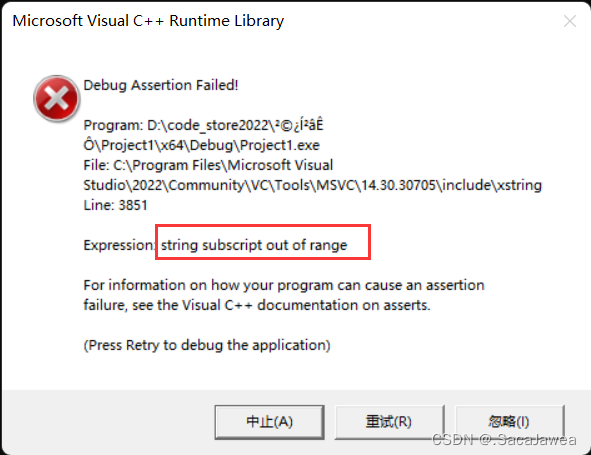
用at接口程序报的错就让人拿不准了
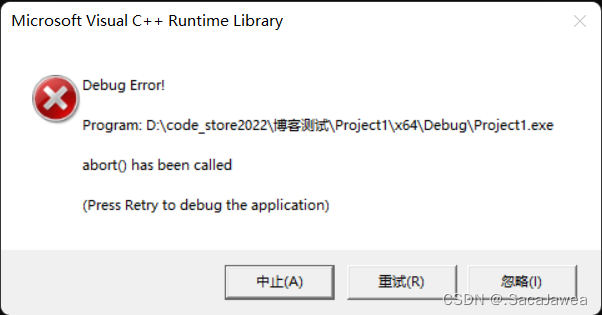
虽然用下标和at接口都能访问string的数据但使用下标访问能在出错时更快找到错误,所以推荐使用下标访问。在使用反向迭代器时,需要输入较长的类型名,string::reverse_iterator,而我们可以使用auto来让编译器根据函数返回类型自动推导类型名,这样也提高了编程效率。
void stringTest5() { string str = "hello"; //string::reverse_iterator it = str.rbegin(); auto it = str.rbegin(); // 与上面的写法等价 while (it != str.rend()) { cout << *it; it++; } }- 1
- 2
- 3
- 4
- 5
- 6
- 7
- 8
- 9
- 10
- 11
string的插入与删除

插入函数有很多重载版本void stringTest6() { string str = "hello"; str.insert(0, 3, 'x'); // 向下标为0处插入3个x cout << str << endl; str.insert(0, " "); // 向下标为0处插入3个空格 cout << str << endl; str.insert(str.begin() + 3, 3, 'y'); // 向下标为3处插入三个y cout << str << endl; str.insert(3, 3, 'z'); // 向下标为3处插入三个z cout << str << endl; }- 1
- 2
- 3
- 4
- 5
- 6
- 7
- 8
- 9
- 10
- 11
- 12
- 13
- 14
- 15

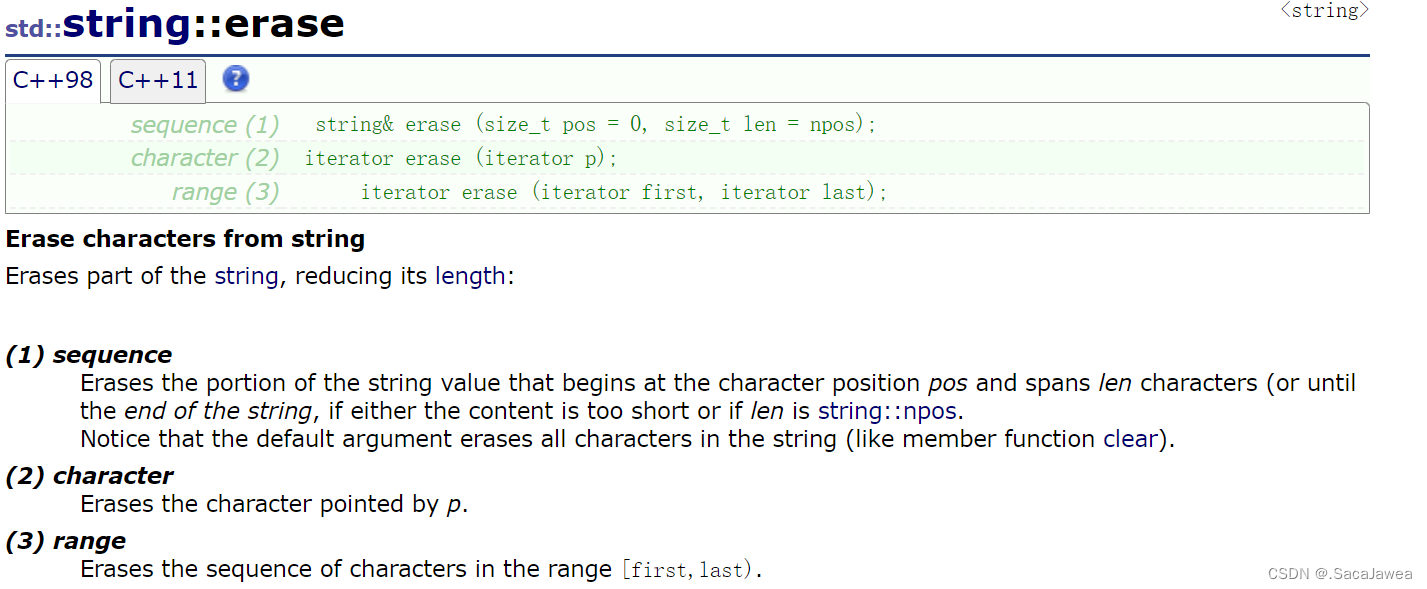
void stringTest7() { string str = "hello"; str.erase(); // 不传参默认删除所有数据 cout << str << endl; str = "hello"; str.erase(str.begin() + 2); // 删除下标为2处的字符 cout << str << endl; str = "hello world"; cout << str << endl; str.erase(2, 5); // 从下标为2向后删除5个字符 cout << str << endl; str = "hello world"; cout << str << endl; str.erase(str.begin() + 2, str.begin() + 5); // 删除从下标为2下标为5的字串 cout << str << endl; }- 1
- 2
- 3
- 4
- 5
- 6
- 7
- 8
- 9
- 10
- 11
- 12
- 13
- 14
- 15
- 16
- 17
- 18
- 19
- 20

string的交换
void stringTest8() { string str1 = "hello"; string str2 = "world"; cout << str1 << endl; cout << str2 << endl; str1.swap(str2); //swap(str1, str2); // 两种交换效率不同 cout << str1 << endl; cout << str2 << endl; }- 1
- 2
- 3
- 4
- 5
- 6
- 7
- 8
- 9
- 10
- 11
- 12
- 13
- 14
使用string的提供的交换接口与标准库中自带的交换函数两者有区别吗?使用string提供的交换只是交换两个指向字符串的指针与两个空间大小,而标准库中的交换则是创建一个中间变量,需要调用拷贝构造,但拷贝是深拷贝需要开辟空间,这样一比较显然string提供的交换效率更高。
string的查找

函数参数基本就是“要查找的字符/字符串”和“要开始查找的位置”,而开始查找的位置默认为0,就是从头开始查找。下面的代码是查找函数的使用void stringTest9() { string file = "test.cpp.txt"; size_t pos = file.rfind('.'); if (pos != string::npos) { cout << file << "后缀:" << file.substr(pos) << endl; } string url = "https://cplusplus.com/reference/string/string/?kw=string"; size_t pos1 = url.find("://"); // 输出协议 if (pos1 != string::npos) cout << url.substr(0, pos1 + 3) << endl; else cout << "非法url" << endl; size_t pos2 = url.find('/', pos1 + 3); // 输出域名 if (pos2 != string::npos) cout << url.substr(pos1 + 3, pos2 - (pos1 + 3)) << endl; else cout << "非法url" << endl; // 输出资源 cout << url.substr(pos2 + 1) << endl; }- 1
- 2
- 3
- 4
- 5
- 6
- 7
- 8
- 9
- 10
- 11
- 12
- 13
- 14
- 15
- 16
- 17
- 18
- 19
- 20
- 21
- 22
- 23
- 24
- 25
- 26
- 27
- 28
- 29
关于string的容量

pushback向string中尾插一个字符。string像一个动态顺序表,有capacity和size保存顺序表的容量和当前的大小,由于string本身存储了一个\0,所以即使是空string也会向内存申请空间以保存\0。
在vs下string的初始容量是15,写一段代码验证capacity的增长void stringTest10() { string str; unsigned int size = str.capacity(); //先记录初始的容量 cout << "capacity:" << str.capacity() << endl; for (size_t i = 0; i < 1000; i++) { str.push_back('c'); if (size != str.capacity()) // 当扩容时打印扩容后的容量 { size = str.capacity(); cout << "capacity:" << str.capacity() << endl; } } }- 1
- 2
- 3
- 4
- 5
- 6
- 7
- 8
- 9
- 10
- 11
- 12
- 13
- 14
- 15
- 16
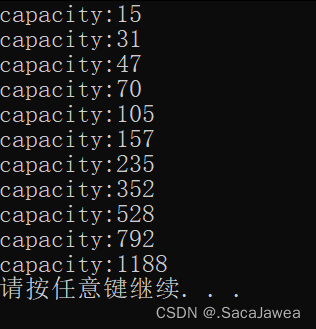
(在vs下)可以看到除了第一次的扩容其他扩容基本都是1.5倍扩,string有一个接口能改变string的容量,当直到string要存储字符串的长度时可以先改变它的容量,以节省扩容开辟空间的时间。

reserve有保留的意思,与reverse要注意区别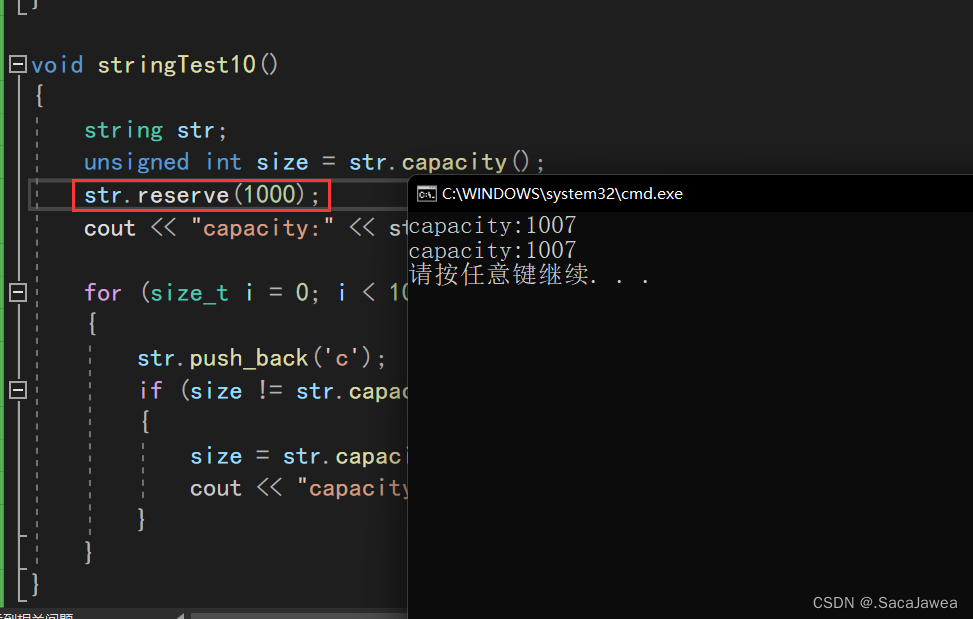
将string的初始容量改为1000后,与刚刚的程序相比,减少了多次扩容

类似的函数还有一个resize,重置string的size,如果只传要重置的大小,这些空间默认会初始化为\0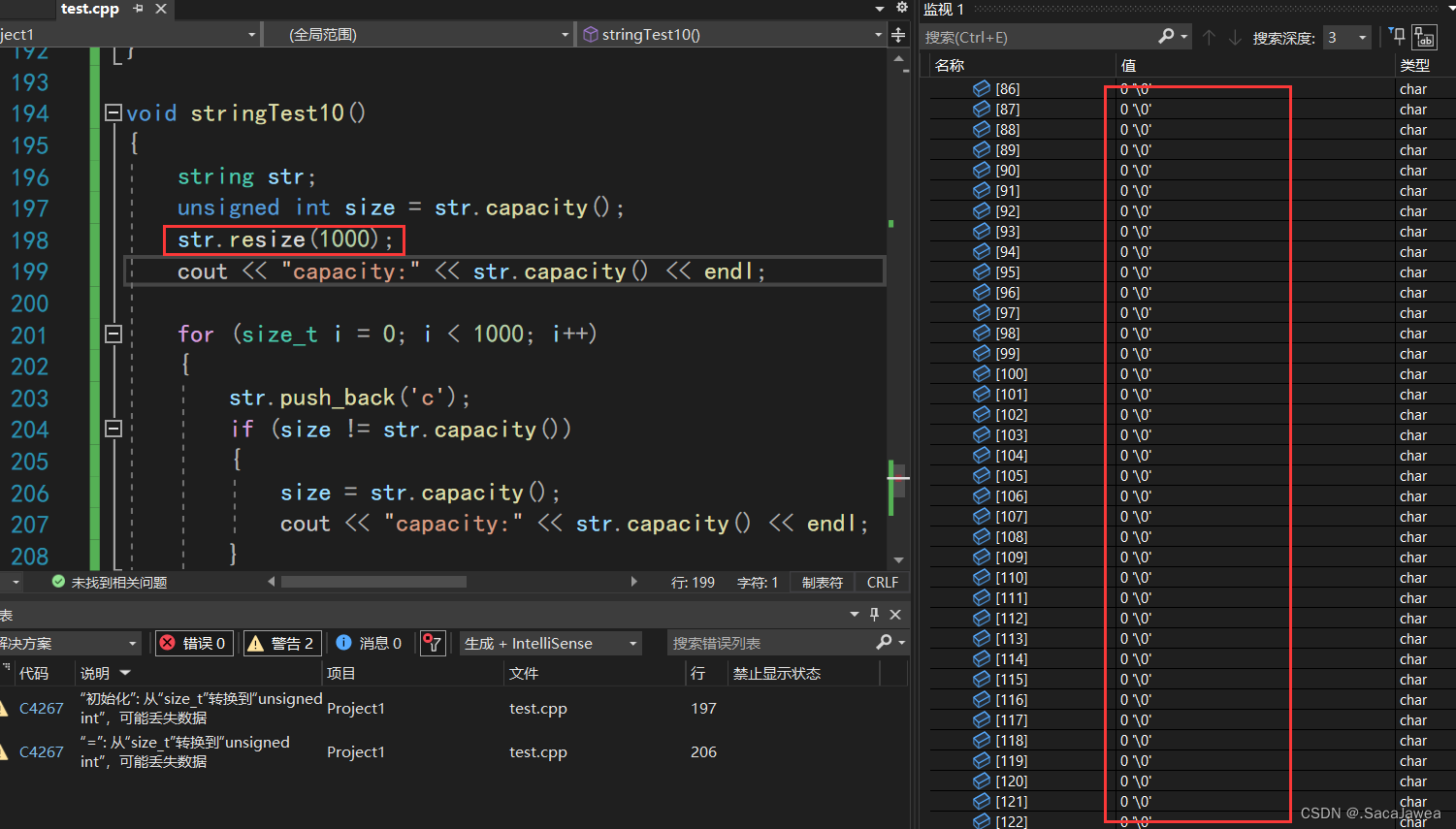
如果再传一个字符,函数会用该字符初始化空间string的模拟实现
string类的声明
namespace myString { class string { public: // 构造和析构 string(const char* str = ""); // string的构造,空串也开辟空间,只存储\0 ~string(); // string的析构 string(const string& str); // string的拷贝构造 string& operator=(const string& str); // string的赋值 void swap(string& str); // 修改 string& operator+=(const string& str); // string的追加 string& operator+=(char c); // string的追加 string& append(const char* str); // string的追加 string& append(char c); // string的追加 void push_back(char c); // string的尾插 string& insert(size_t pos, char c); string& insert(size_t pos, const char* str); string& erase(size_t pos, size_t n); // 从pos位置删除n个字符 const char* c_str() const { return _str; } // 返回c类型的字符串 // 容量 void resize(size_t n, char c = '\0'); // 修改string的大小 void reserve(size_t n); // 修改string的容量 size_t size() const { return _size; } size_t capacity() const { return _capacity; } // 迭代器 typedef char* iterator; typedef const char* const_iterator; // 迭代器的重定义 iterator begin() { return _str; } iterator end() { return _str + _size; } const_iterator begin() const { return _str; } const_iterator end() const { return _str + _size; } // 下标访问 char& operator[](size_t pos); // 通过下标访问string const char& operator[](size_t pos) const; // 通过下标访问string private: char* _str; size_t _size; size_t _capacity; const static size_t npos; }; const size_t string::npos = -1; // 静态变量在类中声明但没有定义,需要在类外定义 }- 1
- 2
- 3
- 4
- 5
- 6
- 7
- 8
- 9
- 10
- 11
- 12
- 13
- 14
- 15
- 16
- 17
- 18
- 19
- 20
- 21
- 22
- 23
- 24
- 25
- 26
- 27
- 28
- 29
- 30
- 31
- 32
- 33
- 34
- 35
- 36
- 37
- 38
- 39
- 40
- 41
- 42
- 43
- 44
- 45
- 46
- 47
- 48
- 49
- 50
- 51
- 52
首先说明capacity表示的是string最大能存储的有效字符个数(不包括’\0’),size表示当前存储的有效字符个数,当然也不包括’\0’,str就是指向存储字符串的指针。
构造和析构

首先实现的是string的构造和析构,构造函数呢,实现成无参的,这样不仅可以构造空串还能传字符串进行构造。先strlen求传入字符串的长度,将长度赋值给_size和_capacity,如果是空串长度就是0,然后为_str分配空间,大小是长度+1,这个1用来存储’\0’,最后再拷贝传入字符串到_str中。
myString::string::string(const char* str)// 说明写了默认参数,定义不用也不能写 { _size = strlen(str); _capacity = _size; _str = new char[_capacity + 1]; strcpy(_str, str); }- 1
- 2
- 3
- 4
- 5
- 6
- 7
析构就是将_str释放,_size和_capacity重置为0。
myString::string::~string() { delete[] _str; _capacity = _size = 0; }- 1
- 2
- 3
- 4
- 5
拷贝构造有两种写法一种是利用构造函数,一种是不利用构造函数,但实现的代码与构造函数重复度高,因此复用构造函数实现拷贝构造更方便。
myString::string::string(const string& str) // 传统写法 { _size = str._size; _capacity = str._capacity; _str = new char[_capacity + 1]; strcpy(_str, str._str); } myString::string::string(const string& str) // 现代写法 { string tmp(str._str); // 先用str的字符串构造tmp对象 // 此时的tmp就是str的复制,只要把tmp与this交换 swap(tmp); }- 1
- 2
- 3
- 4
- 5
- 6
- 7
- 8
- 9
- 10
- 11
- 12
- 13
当然还要实现swap函数,利用std库中的交换将两个指针交换,还有_capacity和_size也要交换
void myString::string::swap(string& str) { std::swap(_str, str._str); std::swap(_capacity, str._capacity); std::swap(_size, str._size); }- 1
- 2
- 3
- 4
- 5
- 6
=的重载同样也是两种写法,传统的繁琐,现代的简洁。不过对于任何=的重载都要注意连续复制的情况,因此函数需要返回赋值完成的对象。
对于传统赋值,先判断容量是否足够存储字符串,若不够需要释放之前的空间再开辟一块足够的空间存储。
myString::string& myString::string::operator=(const string& str) { if (&str != this) // 防止自己赋值给自己 { if (str._size > _capacity) _str = new char[str._size]; // 空间不够的扩容 _size = str._size; _capacity = str._capacity; strcpy(_str, str._str); } return *this; } // 现代写法 myString::string& myString::string::operator=(string str) { swap(str); // 形参不是引用,所有调用了拷贝构造,构造了str,所以str是一个复制 return *this; }- 1
- 2
- 3
- 4
- 5
- 6
- 7
- 8
- 9
- 10
- 11
- 12
- 13
- 14
- 15
- 16
- 17
- 18
- 19
- 20
显而易见,这样的复用构造函数让代码更简单也更简洁了
关于修改

修改无非就是增加与删除,实现了在任意位置的插入与删除,其他的接口也就能复用这两个接口。
说白了,插入就是检查容量,移动数据,插入数据,三个步骤
myString::string& myString::string::insert(size_t pos, char c) { if (_size == _capacity) reserve(_capacity == 0 ? 4 : _capacity * 2); size_t end = _size + 1; // _str[_size]是'\0',一起移动 while (end > pos) { _str[end] = _str[end - 1]; end--; } _str[pos] = c; _size++; return *this; }- 1
- 2
- 3
- 4
- 5
- 6
- 7
- 8
- 9
- 10
- 11
- 12
- 13
- 14
(这里需要补充size_t的一个注意点,如果上面end先指向_size - 1的位置,然后循环写为end >= pos,移动的代码写为 _str[end + 1] = _str[end],这就很有问题,当pos为0,end为0时再走一遍循环,而end-1为-1,对吗?
myString::string& myString::string::insert(size_t pos, char c) { assert(pos <= _size); if (_size == _capacity) reserve(_capacity + 1); size_t end = _size - 1; // 错误示范 while (end >= pos) { _str[end + 1] = _str[end]; end--; } _str[pos] = c; _size++; return *this; }- 1
- 2
- 3
- 4
- 5
- 6
- 7
- 8
- 9
- 10
- 11
- 12
- 13
- 14
- 15
end是无符号数size_t,所以-1存储到end中是一个很大的数,这样使得循环继续,但越界访问。因此不能这样写,总结:使用无符号数比较要特别注意“负数”问题)
插入的另一个重载:插入一串字符到string中,和插入一个字符类似,只是移动字符的距离变长了
myString::string& myString::string::insert(size_t pos, const char* str) { assert(pos <= _size); int len = strlen(str); if (len + _size >= _capacity) // 检查扩容 { reserve(len + _size); } size_t end = _size + len; while (end - len + 1 > pos) { _str[end] = _str[end - len]; end--; } memcpy(_str + pos, str, len); _size += len; return *this; }- 1
- 2
- 3
- 4
- 5
- 6
- 7
- 8
- 9
- 10
- 11
- 12
- 13
- 14
- 15
- 16
- 17
- 18
- 19
删除字符:函数第一个参数是要删除字符的位置,后一个参数是要删除字符的个数。如果位置加上字符个数大于字符串长度,就是把该位置后面的字符全删除,直接在该位置上放个’\0’。但如果不是全删除就需要移动后面的字符覆盖前面的字符。
myString::string& myString::string::erase(size_t pos, size_t n) { assert(pos < _size); if (n + pos >= _size) { _str[pos] = '\0'; _size = pos; // n的值可以是npos,不能减去npos因为npos可能是-1,最大的数 return *this; } else { size_t end = pos + n; // 用end移动数据 while (end <= _size) // 把'\0'也移过去 { _str[end - n] = _str[end]; end++; } size -= n; return *this; } }- 1
- 2
- 3
- 4
- 5
- 6
- 7
- 8
- 9
- 10
- 11
- 12
- 13
- 14
- 15
- 16
- 17
- 18
- 19
- 20
- 21

npos是一个最大的数,无符号的-1,作为string的静态成员。剩下的接口就是复用insert和erase函数了
myString::string& myString::string::operator+=(const string& str) { return insert(_size, str._str); } myString::string& myString::string::operator+=(char c) { return insert(_size, c); } myString::string& myString::string::append(const char* str) { return insert(_size, str); } myString::string& myString::string::append(char c) { return insert(_size, c); } void myString::string::push_back(char c) { insert(_size, c); }- 1
- 2
- 3
- 4
- 5
- 6
- 7
- 8
- 9
- 10
- 11
- 12
- 13
- 14
- 15
- 16
- 17
- 18
- 19
- 20
- 21
- 22
- 23
- 24
- 25
(范围for底层是迭代器,不实现迭代器就不能用范围for,并且迭代器的命名必须按约定走。假设我把模拟实现的迭代器屏蔽,程序报错)

关于容量

reserve为string扩容,先检查n是否大于当前容量,如果大于则扩容,小于不缩容。先开辟新的空间,将原来空间的数据拷贝到新空间,再释放原来的空间。void myString::string::reserve(size_t n) { if (n > _capacity) { char* tmp = new char[n + 1]; strcpy(tmp, _str); delete[] _str; _str = tmp; _capacity = n; } }- 1
- 2
- 3
- 4
- 5
- 6
- 7
- 8
- 9
- 10
- 11
resize就是reserve加初始化了,没有给初始化的值就用’\0’初始化。
void myString::string::reserve(size_t n, char c) { if (n > _capacity) reserve(n); while (_size < n) _str[_size++] = c; _size = n; // 如果n小于_size,上面的while不会进去,但长度要减小 _str[n] = '\0'; // 最后再结束的地方放'\0' } }- 1
- 2
- 3
- 4
- 5
- 6
- 7
- 8
- 9
- 10
- 11
- 12
下标访问

重载[],通过下标访问字符串,但要注意如果string被const修饰则不能写入字符串,所以需要重载两个版本来支持const对象char& myString::string::operator[](size_t pos) { assert(pos < _size); return _str[pos]; } const char& myString::string::operator[](size_t pos) const { assert(pos < _size); return _str[pos]; }- 1
- 2
- 3
- 4
- 5
- 6
- 7
- 8
- 9
- 10
- 11
cin和cout的重载
cout的重载不能直接输出字符串,而是应该一个字符一个字符的输出,考虑到极端情况,string中存储了’\0’,直接输出的话字符串也就不完整
ostream& operator<<(ostream& out, const myString::string& str) { for (int i = 0; i < _size; i++) { out << _str[i]; } return out; // 为了支持连续输出 }- 1
- 2
- 3
- 4
- 5
- 6
- 7
- 8
cin的重载也是一个一个字符的读,直到读入的字符为空格或者换行,但是直接使用>>遇到空格和换行也是停止的,所以>>永远无法读入空格和换行,要用istream对象的get函数,每次读一个字符,但不会停止
istream& operator>>(istream& in, myString::string& str) { char ch; ch = in.get(); while (ch != ' ' && ch != '\n') { push_back(ch); ch = in.get(); } return in; }- 1
- 2
- 3
- 4
- 5
- 6
- 7
- 8
- 9
- 10
- 11
-
相关阅读:
【草稿】DNS配置问题引起的java.net.UnknownHostException
信号驱动io
Java剑指Offer根据前序中序重建二叉树
springboot集成kafka
C++初阶-类和对象(上)
Cisco简单配置(七)—组建一个简单局域网
软考中级电子商务师含金量高嘛?
关于Linux中如何使用 systemd-run创建临时Cgroup来限制ad-hoc的资源消耗
macOS通过钥匙串访问找回WiFi密码
线性代数 | 最小二乘法的直观理解
- 原文地址:https://blog.csdn.net/weixin_61432764/article/details/126075245
